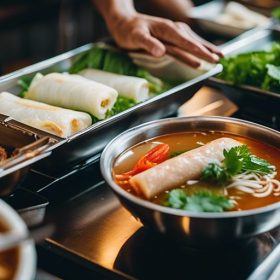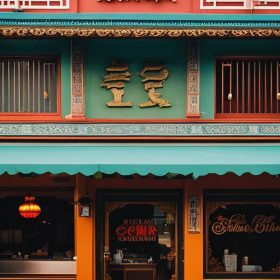Vietnamese cuisine is known for its fresh and vibrant flavors, making it one of the most popular cuisines in the world. The history of Vietnamese cuisine dates back thousands of years, with influences from neighboring countries such as China and Cambodia. Over time, Vietnamese cuisine has developed its own unique identity, blending flavors and techniques from various regions.
Vietnam is divided into three main regions: the North, Central, and South. Each region has its own distinct culinary traditions and flavors. In the North, the cuisine is influenced by Chinese cooking techniques and tends to be lighter and less spicy. Central Vietnamese cuisine is known for its bold and spicy flavors, while Southern Vietnamese cuisine is characterized by its use of fresh herbs and tropical fruits.
Why You Need a Tour Guide to Discover Hidden Gems
When it comes to exploring the food scene in Vietnam, having a local tour guide can make all the difference. A tour guide not only knows the best places to eat, but they can also provide valuable insights into the culture and history behind the dishes.
One of the main benefits of having a tour guide is their knowledge of hidden gems that may not be easily found by tourists. They can take you to local street food stalls or family-run restaurants that serve authentic and delicious dishes. These hidden gems often offer a more immersive experience, allowing you to interact with locals and learn about their food traditions.
Additionally, a tour guide can provide valuable context and background information about the dishes you are trying. They can explain the ingredients used, the cooking techniques involved, and the cultural significance of certain dishes. This not only enhances your dining experience but also deepens your understanding and appreciation of Vietnamese cuisine.
The Importance of Street Food in Vietnamese Cuisine
Street food is an integral part of Vietnamese culture and cuisine. It is a way for locals to grab a quick and affordable meal on the go, and it offers a wide variety of flavors and dishes to choose from. In Vietnam, street food stalls can be found on almost every corner, offering everything from banh mi sandwiches to pho noodle soup.
Some popular street food dishes include banh mi, a Vietnamese sandwich filled with various meats, pickled vegetables, and herbs; banh xeo, a crispy pancake filled with shrimp, pork, and bean sprouts; and bun cha, grilled pork served with rice noodles and fresh herbs.
To experience the best of Vietnamese street food, it is recommended to visit local markets or street food alleys. These bustling areas are filled with food stalls and vendors selling a wide variety of dishes. It’s a great way to immerse yourself in the local culture and try authentic Vietnamese flavors.
Exploring the Flavors of Northern Vietnamese Cuisine
Northern Vietnamese cuisine is known for its simplicity and delicate flavors. The cuisine is heavily influenced by Chinese cooking techniques, with an emphasis on stir-frying, steaming, and braising. The flavors tend to be lighter and less spicy compared to other regions.
One of the most famous dishes from Northern Vietnam is pho, a flavorful noodle soup made with beef or chicken broth, rice noodles, and various toppings such as beef slices, bean sprouts, and herbs. Another popular dish is bun cha, which consists of grilled pork served with rice noodles, fresh herbs, and a dipping sauce.
Northern Vietnamese cuisine also makes use of unique ingredients such as green papaya, which is often used in salads, and fermented shrimp paste, which adds a distinct umami flavor to dishes. The region is also known for its love of pickled vegetables, which are often served as a side dish or used as a condiment.
The Unique Characteristics of Central Vietnamese Cuisine
Central Vietnamese cuisine is known for its bold and spicy flavors. The region’s cuisine is influenced by the royal cuisine of the Nguyen Dynasty, as well as the flavors of neighboring countries such as Laos and Cambodia. Central Vietnamese dishes often feature a combination of sweet, sour, salty, and spicy flavors.
One of the most famous dishes from Central Vietnam is bun bo Hue, a spicy beef noodle soup that originated in the city of Hue. The soup is made with beef broth, lemongrass, shrimp paste, and chili oil, and is typically served with rice noodles, beef slices, and various herbs.
Another popular dish from the region is cao lau, a noodle dish made with thick rice noodles, pork slices, bean sprouts, and herbs. The noodles are cooked in water from a special well in Hoi An, giving them a unique texture and flavor.
Central Vietnamese cuisine also makes use of unique ingredients such as shrimp paste, which is used to add depth of flavor to dishes, and fish sauce, which is used as a condiment or dipping sauce. The region is also known for its love of fresh herbs and vegetables, which are often used to add freshness and crunch to dishes.
Discovering the Richness of Southern Vietnamese Cuisine
Southern Vietnamese cuisine is known for its use of fresh herbs and tropical fruits. The region’s cuisine is influenced by the flavors of Cambodia and Thailand, as well as the abundance of ingredients available in the Mekong Delta.
One of the most famous dishes from Southern Vietnam is banh xeo, a crispy pancake filled with shrimp, pork, bean sprouts, and herbs. The pancake is made with rice flour and turmeric powder, giving it a vibrant yellow color.
Another popular dish from the region is hu tieu, a noodle soup made with pork broth and various toppings such as pork slices, shrimp, and quail eggs. The soup is typically served with rice noodles and fresh herbs.
Southern Vietnamese cuisine also makes use of unique ingredients such as coconut milk, which is used to add richness and creaminess to dishes, and tamarind, which is used to add a tangy flavor. The region is also known for its love of tropical fruits such as mangoes, pineapples, and dragon fruit, which are often used in desserts and drinks.
The Role of Herbs and Spices in Vietnamese Cooking
Herbs and spices play a crucial role in Vietnamese cuisine, adding depth of flavor and aroma to dishes. Vietnamese cuisine is known for its use of fresh herbs such as mint, cilantro, and Thai basil, which are often used as garnishes or added to dishes for freshness and fragrance.
Spices such as star anise, cinnamon, and cloves are commonly used in Vietnamese cooking to add warmth and complexity to dishes. These spices are often used in marinades for meats or added to broths for soups and stews.
Fish sauce is another key ingredient in Vietnamese cuisine. It is made from fermented fish and adds a savory umami flavor to dishes. Fish sauce is often used as a condiment or dipping sauce, and it is an essential ingredient in many Vietnamese dishes.
Uncovering the Secrets of Vietnamese Noodle Dishes
Noodles are a staple in Vietnamese cuisine and come in various shapes and sizes. Each type of noodle has its own unique texture and flavor, making them versatile ingredients in Vietnamese cooking.
One of the most popular types of noodles in Vietnam is rice noodles, which are made from rice flour. Rice noodles can be found in dishes such as pho, bun cha, and bun bo Hue. They have a soft and chewy texture that absorbs the flavors of the broth or sauce they are cooked in.
Another popular type of noodle is egg noodles, which are made from wheat flour and eggs. Egg noodles can be found in dishes such as mi xao, a stir-fried noodle dish with various toppings such as chicken, beef, or seafood. Egg noodles have a slightly chewy texture and a rich flavor.
Other types of noodles used in Vietnamese cuisine include glass noodles, which are made from mung bean starch and have a transparent appearance, and vermicelli noodles, which are thin and delicate and often used in salads or spring rolls.
The Significance of Rice in Vietnamese Cuisine
Rice is a staple in Vietnamese cuisine and plays a central role in the country’s food culture. Rice is not only a source of sustenance but also a symbol of prosperity and abundance.
There are many different types of rice used in Vietnamese cooking, including jasmine rice, sticky rice, and broken rice. Jasmine rice is the most commonly consumed type of rice in Vietnam and is known for its fragrant aroma and fluffy texture. Sticky rice is often used in desserts or savory dishes such as sticky rice with chicken or pork.
One popular dish that showcases the importance of rice in Vietnamese cuisine is com tam, which translates to “broken rice.” Com tam is made from broken grains of rice and is typically served with grilled pork chops, pickled vegetables, and a fried egg. It is a hearty and satisfying dish that is enjoyed by locals and tourists alike.
Rice is also used to make various types of rice paper, which is used to wrap spring rolls or to make banh cuon, a steamed rice roll filled with ground pork and mushrooms. Rice paper has a soft and chewy texture that adds a unique element to these dishes.
Indulging in Vietnamese Desserts and Drinks
Vietnamese cuisine offers a wide variety of desserts and drinks that are both refreshing and delicious. Many Vietnamese desserts feature tropical fruits such as mangoes, pineapples, and coconuts, which are abundant in the country.
One popular dessert is che, a sweet soup made with coconut milk, beans, and various types of jelly or fruit. Che comes in many different flavors and variations, such as che ba mau (three-color dessert) and che dau xanh (mung bean dessert).
Another popular dessert is banh flan, a Vietnamese version of caramel custard. Banh flan is made with eggs, sugar, and milk, and is typically served with a caramel sauce on top.
When it comes to drinks, Vietnamese cuisine is known for its refreshing iced coffee and fruit smoothies. Vietnamese iced coffee, also known as ca phe sua da, is made with strong brewed coffee and sweetened condensed milk, which gives it a rich and creamy flavor. Fruit smoothies are made with fresh fruits such as mangoes, strawberries, or avocados, blended with ice and sweetened with sugar or condensed milk.
Embracing the Diversity of Vietnamese Cuisine
Vietnamese cuisine is a rich and diverse culinary tradition that offers a wide range of flavors and dishes. From the delicate flavors of Northern Vietnamese cuisine to the bold and spicy flavors of Central Vietnam, to the fresh and vibrant flavors of Southern Vietnam, there is something for everyone to enjoy.
By embracing the diversity of Vietnamese cuisine and trying new dishes, you can truly experience the richness and complexity of this culinary tradition. Whether you’re exploring the street food scene in Hanoi or indulging in a bowl of pho in Ho Chi Minh City, Vietnamese cuisine is sure to leave a lasting impression on your taste buds. So don’t be afraid to step out of your comfort zone and embrace the flavors of Vietnam.

Cuong Nguyen is a talented writer and experienced waitress at Vietnampalace.net, a renowned Vietnamese restaurant that offers an extensive menu of authentic Vietnamese cuisine. With a background in the competition of Vietnamese cuisine, Cuong brings a wealth of knowledge and expertise to the dining experience. From delicious pho dishes to fresh spring rolls, Cuong ensures that every meal is made with the freshest ingredients and authentic flavors.With exceptional service and a friendly atmosphere, Cuong takes pride in providing a memorable dining experience for every customer.
Whether you’re a vegetarian looking for options or a meat lover craving the flavors of traditional Vietnamese dishes, Cuong guarantees a delightful culinary adventure. So, visit Vietnampalace.net and let Cuong guide you through the tantalizing world of Vietnamese cuisine.



